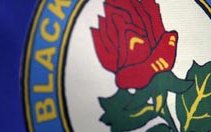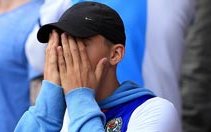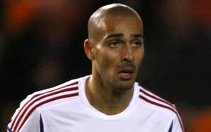Blackburn Rovers – Who Are We? A look back at the club from it’s roots to the present day.
Full name: Blackburn Rovers Football Club
Nickname: Rovers
Founded: 1875
Turned Professional: 1880
Ground: Ewood Park, Blackburn
Capacity: 31,367
Chairman: John Williams
Manager: Mark Hughes
League: FA Premier League
The Lancashire club was founded Blackburn Rovers in 1875, being the idea of John Lewis and Arthur Constantine during a seventeen-man meeting at the Leger Hotel, Blackburn.
Blackburn played their first ever match in Church, Lancashire on 18th December 1875 and went on to draw the game 1-1. There appears to be no record of the team who played or their opponents, but the players thought to have featured for Rovers are:
Thomas Greenwood
Jack Baldwin
Fred Birtwistle
Arthur Thomas
J. T. Sycelmore
Walter Duckworth
John Lewis
Thomas Dean
Arthur Constantine
Harry Greenwood
Richard Birtwistle
The players are believed to have ligned up in a very attacking formation common to that era, but one that would be almost unheard of nowadays of 2-2-6.
At the time of the first match, Rovers did not have a ground of their own, not acquiring one until the 1876-1877 season. Rovers rented a piece of farmland at Oozehead, on the west side of town facing Preston New Road. The ground was only a small meadow with a pool in the middle that had to be covered with planks and turf when they were to play. It was not an ideal situation but it would atleast mark the beginning of the club bringing in revenue. The occasional game was also played at Pleasington cricket ground.
Eventually Rovers rented and played at Alexandra Meadows, East Lancashire`s Cricket Club, where the inaugural game was played against Partick Thistle. Rovers won the game 2-1, with two goals from Richard Birtwistle.
On September 28th 1878 Blackburn Rovers became one of 23 clubs that formed the Lancashire Football Association and November 1st 1879 saw the club play it`s first FA Cup tie in a tournament that would play a prominent part in Rovers trophy winning success. Rovers won the first round with an impressive 5-1 win over Tyne Association FC but eventually fell in the third round with a heavy 6-0 defeat to Nottingham Forest.
The 1881/82 season saw Blackburn as the leading club in the Lancashire area. They continued to rent the facilities at Alexandra Meadows but as the club was fast growing, began looking elsewhere for a ground of their own. Eventually a ground was to be leased at Leamington Street.
The same year saw Rovers achieve a successful run in the FA Cup, becoming the first provincial team to reach the final but unfortunately lost 1-0 to Old Etonians.
The following season of 1882/83 saw the first provincial team win the FA Cup. It just happened to be local rivals Blackburn Olympic. Rovers did however go on to clinch the FA Cup on 29th March 1884 at the Kennington Oval, beating Scottish team Queens Park FC 2-1. Rovers defended this title the following season, yet again beating Queens Park FC, this time 2-0 and the following season winning a third successive FA Cup title against West Bromwich Albion. As reward for a hat-trick of FA Cup victories, Rovers were awarded a specially commissioned silver shield, with the unique privilege of displaying the club crest on its corner flags.
1885/86 saw a new era which introduced the professional footballer, meaning players would now be receiving a wage. £615 was given out as wages by Rovers for this season.
March of 1888 was to see things change for the better. A Birmingham shop keeper by the name of William McGregor, also a committee member of Aston Villa was to send out letters to five football clubs, Rovers being one of them. The letter sent on March 2nd was to suggest a series of home and away matches amongst twelve different clubs. As there had already been the introduction of professional footballers, it seemed logical that this be the next step. The meeting took place on March 22nd at the Anderton Hotel with John Birtwistle representing Rovers. After this and several other meetings, the football league was invented. Rovers finished fourth in the inaugural season, impressively remaining unbeaten at home.
1890 saw Rovers once again reach the FA Cup final in which they played Sheffield Wednesday. The match took place on March 29th at the Kennington Oval. Rovers won 6-1 with William Townley scoring what was to be the first FA Cup Final hat-trick.
The summer of the same year was to also see another significant event as Rovers chose to move again. The new home was Ewood Park, which is still their home to this day.
Ewood Park was built in 1882 and had hosted a series of sporting events. Rovers spent a further £1000 refurbishing the ground to bring it up to standard. The first match was played September 13th 1890 against Accrington. The result was a 0-0 draw.
The 1890/91 season was to bring yet more FA Cup success with a 3-1 win over Notts County. This marked their fifth FA Cup trophy; however the fortunes of Rovers were to change with the next two decades bringing little success. During the 1896/97 season, Rovers had a disastrous spell and looked doomed for relegation, but however stayed in the first division due to the addition of new teams. Although this season was a disaster, it did earmark the beginning of Bob Crompton`s 50-year association as both a player and an eventual FA Cup winning manager.
The rest of the century was no better than the 1896/97 season with many narrow escapes from relegation and it did not get any better with the early years of the 20th century. Things did start to gradually get better. Major renovations began to take place in the grounds with the Darwen end being covered at a cost of £1680 in 1905 and the Nuttall Stand was to be opened on New Years Day 1907.
Despite a not so bright start to the century, Rovers were still considered a top English League side. 1912 would see Rovers crowned as Champions of England for their first time and 1914 would see them repeat the feat. Had it not been for World War I and the postponement of football, who knows how many more titles Rovers could have won? It wouldn`t be until 1928 that more glory would be achieved as they won the FA Cup. However, unknown at the time, it would be nearly 70 years until the capture of their next major trophy.
The next four decades were spent bouncing between Division one and two. 1960 saw Rovers reach the FA Cup final. However, they went on to loose 3-0 to Wolverhampton Wonderers. Full back Dave Whelan (now chairman of Wigan) broke his leg in the first half of the game, which would prove to be his last match as a professional footballer. The majority of the game was played with only ten men, this being due to the days before substitutes were to be used. 1966 saw them relegated from the first division and they wouldn`t return for twenty-six years.
Things would get worse still in the 1970`s with Rovers to and from second and third division. They won the third division in 1974/75 but never really pushed for promotion to the first division despite the efforts of quality managers such as Jim Smith. 1980 saw them promoted from the third to second division as runners up and they have remained in these two upper divisions ever since.
Rovers would not see the top division until the early 90`s. 1988/89 and 89/90 saw Rovers reach the playoffs with the 88/89 season seeing them loose to Crystal Palace. This was to be the last year of the home and away two-legged final. The following season 89/90 saw Blackburn go out in the Semi-final of the playoffs. The following season saw the appointment of lifelong supporter and local Steelworks owner, the late Jack Walker.
Despite Walker`s takeover of the club, Rovers finished the 1990/91 campaign in 19th position, as his appointment was too late to prevent the dismal season. Don Mackay remained manager at the start of 1991/92, but was succeeded by Kenny Dalglish. This was to be a great move as Dalglish had proved himself as a manager winning five major trophies with Liverpool in six years. Millions of Walker`s wealth was available to strengthen the club and Dalglish made some substantial signings, which changed the fortunes of Rovers seeing them finish in 6th position. This got them into the playoffs and Rovers won the final 1-0 against Leicester City thanks to a Mike Newell penalty to book their place in the new Premier League.
The summer of the same year saw Rovers pay an English record fee of £3.5 million for Southampton and England forward Alan Shearer. Other new signings for this season saw defender Graeme Le Saux move from Chelsea, striker Kevin Gallacher from Coventry and Middlesbrough winger Stuart Ripley. This big money spending showed that Blackburn meant business and the majority of the season saw them challenging for the title which was pretty impressive as was their first season back in the top tier of English football. Rovers finished the 1992/93 season with an impressive 4th place. This back then however was not enough to get into Europe. The 1993/94 season saw Leeds` David Batty and Southampton`s Tim Flowers added to the squad and they were key players in helping Rovers finish 2nd to Manchester United.
A few weeks later, Norwich`s Chris Sutton was bought for £5 million, breaking the English transfer record yet again. Sutton forged an amazing striking partnership with Alan Shearer with the duo being dubbed ‘SAS` meaning Sutton and Shearer.
Rovers suffered early exits from all cup-ties during the 1994/95 season, this was not all bad though as they were able to concentrate solely on challenging Manchester United for the Premiership crown. Rovers had led for the majority of the season, but it looked as if they had blown it as they lost to Liverpool 2-1 on the final day. This meant that a Manchester United win would snatch the title from their grasp, but with fate on Blackburn`s side, history was to be made. West Ham held United to a 1-1 draw seeing Rovers winning the top tier English title for the first time since 1914. Within five years Jack Walker`s vision had become reality. He had transformed Rovers from strugglers of the old Second Division to Premier League champions.
The 1995/96 season would see Ray Harford as the new manager for the next two years. Kenny Dalglish made the move upstairs to Director of Football at the end of the Championship season. Blackburn saw themselves in the bottom half for the first half of the season due to a poor start. In the Champions League they finished a disappointing bottom of their group with just 4 points. The season would see Ewood Park redeveloped and on the official opening Rovers beat Nottingham Forrest with an impressive 7-0 victory. That along with a 4-1 victory over Rosenborg with Mike Newell scoring a nine-minute hat trick was to be the highlights of a fairly disappointing season. For the third season in a row Shearer would score over 30 goals, making him the first striker to do so in three successive seasons. The summer saw Alan Shearer depart to his home town Newcastle United for a world record £15 million. Although a lot of money, Rovers were unable to find another natural goal scorer of his ability.
The 1996/97 campaign was to see their fortunes change for the worst with Rovers failing to win a single game in their first ten, rooting them to the bottom of the table. This saw Ray Harford resign as manager in late October. The season was looking bleak with Rovers staring at relegation. They did however survive finishing in 13th place thanks to caretaker manager Tony Parkes.
It was announced on December 16th at a press conference that Sven-Göran Eriksson had signed an unconditional contract to take over as manager at the end of the season once his contract with Italian Serie A club Sampdoria expired. It appeared that Rovers were set to get the top manager they were after and there was no arguing about the quality as Eriksson had a wealth of success and experience having won the UEFA Cup, Portuguese Championship and Coppa Italia. Expectations were to be high with Jack Walker wanting Europe to ba a regularity. To the disappointment of the club and the fans Eriksson did not join Rovers and went on to eventually manage Lazio instead as he wanted to stay in Italy with his children due to the collapse of his marriage. It would turn out to be even more gutting for Rovers as with Lazio he won the Italian Championship and UEFA Cup Winners` Cup, success that Blackburn much sought after.
The summer of 1997 saw the appointment of Roy Hodgson as new manager. Things were looking bright and during his first season at the reigns he guided Rovers to UEFA Cup qualification. However the following December was to see him axed as poor form left Rovers hovering towards the bottom of the table. Manchester United assistant manager Brian Kidd was brought in to try and salvage the season, but despite his success under the wing of Alex Ferguson, he was unable to repeat this as boss at Rovers and avoid relegation. Rovers` fate was decided on the final game of the season, which just happened to be a 0-0 draw with Manchester United with United clinching a memorable treble.
1999/00 started with Blackburn favourites to bounce straight back to the top elite but the campaign took off to a bad start with Rovers just above the Division One relegation zone, resulting in Brian Kidd being another booted out by Walker. Tony Parkes once again was named caretaker manager and was eventually supposed to succeed full-time for the rest of the season. This was not the case though as Graeme Souness was appointed as new boss in March. The start of the 2000/01 saw the sad loss of Chairman Jack Walker. This was a sad time for the team and all fans. The Rovers promotion challenge was dedicated to the memory of Walker and no doubt this helped motivate the team to achieve this in the same year as runners-up to Fulham.
The 2001/2002 season ended with Rovers finishing 10th and a good League Cup run saw them reach the final at the Cardiff Millennium Stadium and defeat Tottenham Hotspur 2-1. The following season would see Rovers qualify for Europe again under Souness` leadership, after finishing the season in 6th place.
After two decent years in the Premiership the third successive was not to be very successful. Rovers finished a disappointing 15th, putting a strain on the position of Souness. Following the start of the 2004/05 season Souness departed to take control at Newcastle United. Wales manager Mark Hughes was brought in as replacement. Hughes was not a stranger to Blackburn as he had represented as a player, playing a key role in gaining promotion back to the Premiership and League Cup success. Hughes successfully kept the club up with a 15th place finish as well as a good FA Cup run crashing out in the semi-final against Arsenal. Hughes signed fellow Welsh star Craig Bellamy for the 2005/06 season from Newcastle for around £4.5 million and he went on to play a huge role with some fine displays helping Rovers finish 6th and qualify for Europe.
The future is looking bright for Rovers and the club as well as the fans hope to be a success in Europe and for the club to go from strength to strength…



